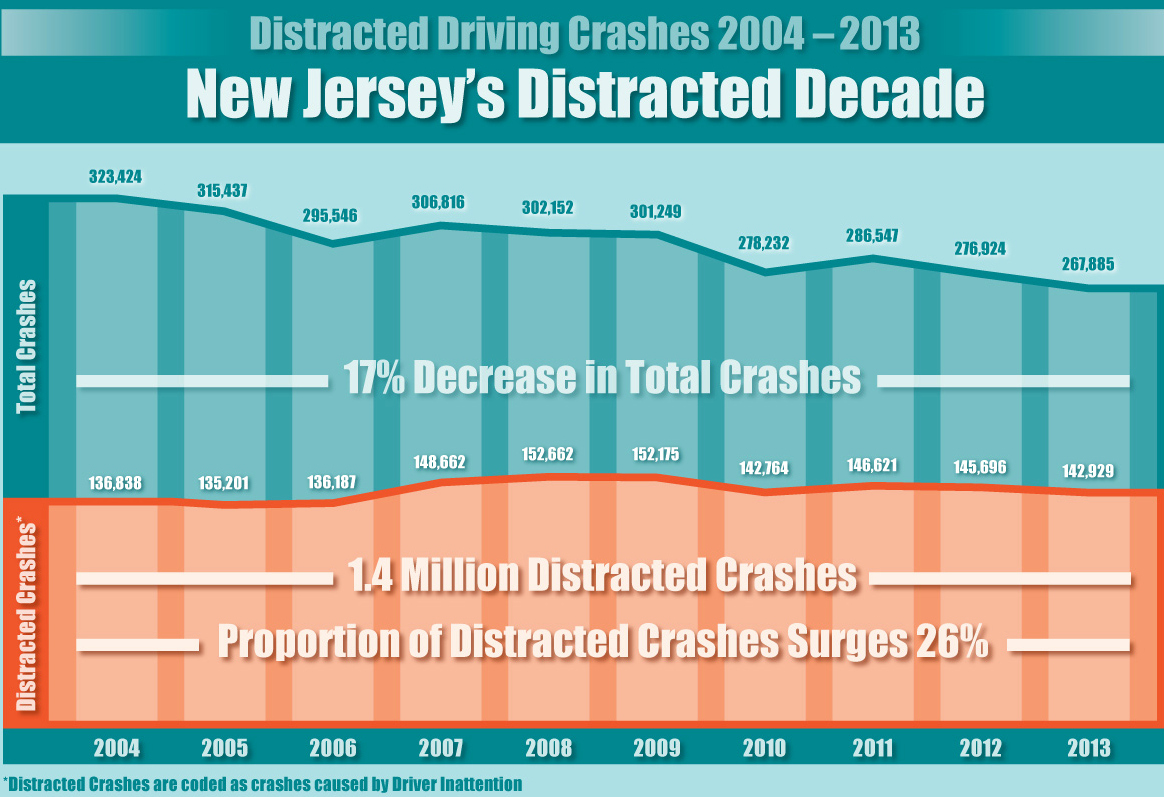

New Jersey’s Acting Attorney General John Hoffman this week announced the staggering toll driver inattention has taken on New Jersey’s roadways in the past 10 years.
Hoffman said New Jersey has experienced a “distracted driving decade” during the past 10 years but that an ongoing law enforcement initiative is working to help end this crisis.
From 2004 to 2013, driver inattention was “a major contributing circumstance” in 1.4 million crashes in New Jersey, which represent about half of the total crashes in the state during that period, according to the Attorney General’s office.
Distraction was the number one contributing circumstance in total crashes. And in one decade (2003-2012), more than 1,600 people have been killed in crashes where driver inattention was a major contributing factor.
“The numbers tell the sad truth: we are in the midst of a surge in driver inattention, and crash statistics bear out that we can characterize the last 10 years simply as ‘New Jersey’s Distracted Driving Decade,'” said Hoffman.
What is perhaps most troubling about these numbers is that the issue of distracted driving seems to be getting progressively worse, Hoffman said. The research indicates that while crashes and fatalities are trending downward as a whole, the number and proportion of distracted crashes are rising, he said.
At the beginning of the “Distracted Driving Decade” in 2004, driver inattention was cited as a major contributing circumstance in 42 percent of crashes. But that number has risen in those 10 years and last year it peaked at 53 percent. And the proportion of distracted crashes has surged 26 percent in that time span, according to the Attorney General’s office.
“In recent years smartphones and other devices have become more sophisticated and it’s clear to most of us that they’re being used more by drivers,” said Gary Poedubicky, acting director of the New Jersey Division of Highway Traffic Safety.
“Though the overall picture of road safety is brightening, one cannot help but conclude that there is an increasing addiction to distraction for drivers,” Poedubicky said. “We need to put an end to the epidemic of driver inattention and close the book on the ‘Distracted Driving Decade.'”
In an effort to stop distracted driving, the New Jersey Division of Highway Traffic Safety has for the first time made funds available to law enforcement agencies for a statewide crackdown on motorists who are using a handheld device while driving, which is illegal in New Jersey.
Sixty police departments received $5,000 each for the campaign called “U Drive. U Text. U Pay.” The funds will be used to pay for checkpoints and increased patrols. Many more enforcement agencies are also expected to participate unfunded in the initiative, which was funded and developed by the National Highway Traffic Safety Administration (NHTSA).
About halfway through the three-week campaign, which runs from April 1 to 21, the funded departments have issued an estimated 3,000 summonses for cell phone and electronic device violations.
“People need to know that we are serious about stopping this deadly behavior,” said NHTSA Region 2 Administrator Thomas M. Louizou. “Using a handheld phone and texting has reached epidemic levels. When you text or talk on the phone while driving, you take your focus off the road. That puts everyone else’s lives in danger, and no one has the right to do that.”
Officials said this increased police presence on the roads will soon be paired with stepped-up penalties for breaking New Jersey’s primary cell phone law.
Currently, motorists violating New Jersey’s primary cell phone law face a $100 fine plus court costs and fees. Because of a new law signed by Gov. Chris Christie last year, penalties for that transgression will get stiffer. On July 1, those penalties will rise to a range of $200 to $400 for a first offense, $400 to $600 for a second, and up to $800 and three insurance points for subsequent violations.
These changes follow the adoption in 2012 of the “Kulesh, Kubert and Bolis Law.” Under that law, proof that a defendant was operating a hand-held wireless telephone while driving a motor vehicle may give rise to the presumption that the defendant was engaged in reckless driving. Prosecutors are empowered to charge the offender with committing vehicular homicide or assault when an accident occurs from reckless driving.
Source: Office of the Attorney General

Related Articles: